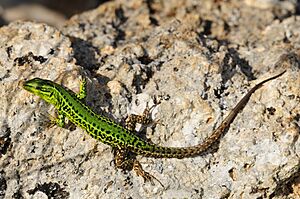Sicilian wall lizard facts for kids
Quick facts for kids Sicilian wall lizard |
|
|---|---|
 |
|
| Conservation status | |
| Scientific classification | |
| Genus: |
Podarcis
|
| Species: |
waglerianus
|
| Synonyms | |
|
|
The Sicilian wall lizard (scientific name: Podarcis waglerianus) is a type of lizard that belongs to the Lacertidae family. This lizard is found only in Italy, specifically on the island of Sicily and the nearby Aegadian Islands. It lives in many different places like forests, bushy areas, grasslands, farms, and even gardens. The IUCN says this lizard is not a threatened species. There are three main types, or subspecies, of the Sicilian wall lizard: P. w. antoninoi, P. w. marettimensis, and P. w. waglerianus.
Contents
What's in a Name?
The second part of the lizard's scientific name, waglerianus, was chosen to honor a German scientist. His name was Johann Georg Wagler, and he studied reptiles and amphibians.
Appearance and Features
The Sicilian wall lizard usually grows to be about 7.5 centimeters (3 inches) long. Male lizards are often a little bit bigger than females. Their backs are usually green, but some females might be olive or brownish.
Most of these lizards have a clear white or yellow stripe along their sides. They often have a brown stripe or a line of dots running down their spine. Males also have more dark spots on their backs and sides. Females, however, often have a more even color.
The underside of the lizard is white, with a spotted throat. But in breeding males, the belly might turn orange, pink, or red. The Sicilian wall lizard looks different from the Italian wall lizard. It has a deeper head, a slimmer body, and its spots are more scattered instead of forming a net-like pattern. Its belly colors are also brighter.
Where They Live
This lizard species is found only in Sicily and the Aegadian Islands. It likes places with lots of plants, such as the edges of forests, bushy hillsides, pastures, and farmland. You can often find them in gardens, especially if they are watered regularly.
Unlike the Italian wall lizard, the Sicilian wall lizard does not climb much. It prefers to stay in areas with thicker plants. It is more common inland, away from the coast. The Italian wall lizard is usually found closer to the coast.
Life Cycle and Reproduction
Female Sicilian wall lizards lay a group of four to six oval-shaped eggs. They usually hide these eggs at the bottom of a plant. The eggs hatch after about eight weeks. When they are newly hatched, the baby lizards are about 5.5 centimeters (2.2 inches) long.
Conservation Status
The Sicilian wall lizard is very common across Sicily. It can live in many different types of places. Scientists believe there are many of these lizards in total. Their numbers are generally stable, meaning they are not decreasing. However, on some smaller islands, their populations might be getting smaller. Because it is so widespread and its numbers are stable, the International Union for Conservation of Nature has listed it as a species of "least concern". This means it is not currently at risk of disappearing.
See also
- List of reptiles of Italy


